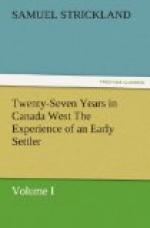The wind changing in our favour, carried us swiftly up the stream, which was still thirty-six miles in breadth, though distant 280 miles from the Gulf. We passed Green Island and the Kamouraska Island, and Goose and Crane Islands. These beautiful islets, which stud the broad bosom of the St. Lawrence, are evidently of volcanic origin. That of Kamouraska displays vast masses of granite, which rise in the form of conical hills, one of which attains the height of five hundred feet. The same features are discernible in the Penguins, and even the strata about Quebec still indicate the same mysterious agency.* [* “Encyclopaedia of Geography,” p. 1304.]
Our progress through the river continually presented the new continent in an attractive point of view. The shores were dotted with farmhouses and adorned with fine gardens and orchards, while lovely islands, covered with lofty trees, rose from the river and delighted the eye. I thought Canada then and I have never changed my opinion since the most beautiful country in the world.
On the 13th of May we passed the Island of Orleans, which we no sooner rounded than the Falls of Montmorenci burst upon my sight. I was unprepared for the scene, which I contemplated in silent astonishment. No words written down by the man, at this distance of time, can describe the vivid feelings of the boy. I have since beheld the mighty cataracts of Niagara, so finely described by its Indian name, “The Thunder of Waters;” but I concur in the general opinion, that if those of Niagara are more stupendous, the Falls of Montmorenci are more beautiful and picturesque.
Quebec soon came in view, with its strong fortress crowning the imposing height of Cape Diamond. No one can look upon the old capital of Canada without remembering that the most gallant British soldier of the age fell in the battle that added the colony to the other dependencies of the English crown.
I remembered, too, with some pleasure, that the paternal dining-room contained a looking-glass one of the fine old Venetian plates, framed with ebony, which had once formed a part of the General’s personal property. It had been for two centuries in his family, but had since become a valued heirloom in mine. His manly features must often have been reflected on its brilliant surface, and that circumstance, which had formerly endeared it to his aged mother, had made it prized by mine.
We have also a bureau, very complete, but evidently constructed more for use than ornament, which might have once contained the papers of this distinguished soldier, while the book-case, to which it was annexed, had probably held his little library. His cruet-stand, which looks as if it had been made in the patriarchal times, is still in use at Reydon Hall.
The reader must pardon this digression, since distinguished worth and valour give an interest even to trivial objects.




